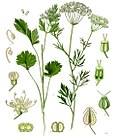Absinthe
An alcoholic beverage derived from botanicals
Absinthe is a highly alcoholic beverage that is derived from various botanicals, including the flowers and leaves of Artemisia absinthium, also known as "grand wormwood," along with anise, fennel, and other medicinal and culinary herbs. It is often referred to as "la fée verte" or "the green fairy" due to its natural green color.
History[edit]
Absinthe originated in the late 18th century in the canton of Neuchâtel in Switzerland. It became popular in late 19th and early 20th century France, particularly among Parisian artists and writers. The drink was associated with bohemian culture and was consumed by famous figures such as Vincent van Gogh, Pablo Picasso, and Ernest Hemingway.
Production[edit]
Absinthe is traditionally prepared by distilling neutral alcohol with botanicals, primarily wormwood, anise, and fennel. The distillation process results in a high-proof spirit that is often diluted with water before consumption. The addition of water causes the drink to louche, or turn cloudy, due to the precipitation of essential oils.
Ingredients[edit]
- Artemisia absinthium: Commonly known as grand wormwood, it is the primary ingredient that gives absinthe its distinctive flavor and name.
- Anise: Provides a sweet, licorice-like flavor.
- Fennel: Adds a sweet and aromatic quality to the drink.
- Other herbs such as hyssop, melissa, and coriander may also be used.
Cultural Impact[edit]
Absinthe has been the subject of many works of art and literature. It was famously depicted in paintings such as Edgar Degas' "L'Absinthe" and Albert Maignan's "La muse verte." The drink was also featured in the writings of Charles Baudelaire, Paul Verlaine, and Arthur Rimbaud.
Controversy and Legal Status[edit]
In the early 20th century, absinthe was banned in many countries due to its alleged harmful effects and association with social disorder. The bans were largely based on the belief that thujone, a compound found in wormwood, was hallucinogenic. Modern research has shown that the thujone content in absinthe is too low to cause such effects.
In recent years, absinthe has experienced a revival, and it is now legal in many countries, including the United States and most of the European Union.
Preparation and Serving[edit]
Absinthe is traditionally served by placing a sugar cube on a specially designed absinthe spoon, which is then placed over a glass containing a measure of absinthe. Cold water is slowly dripped over the sugar cube, dissolving it and diluting the absinthe to taste.
Related pages[edit]
Gallery[edit]
-
A glass of absinthe
-
"La muse verte" by Albert Maignan
-
Absinthe frappé
-
"L'Absinthe" by Edgar Degas
-
Absinthe Beucler
-
Absinthe advertisement
-
Anise plant
-
Fennel plant
-
Foeniculum vulgare
-
Anise seeds
-
Absinthe spoons
-
Absinthe
-
Absinthe
-
Absinthe
-
Absinthe
-
Absinthe
-
Absinthe
-
Absinthe
-
Absinthe
-
Absinthe
-
Absinthe
-
Absinthe
-
Absinthe
Ad. Transform your life with W8MD's Budget GLP-1 injections from $75


W8MD offers a medical weight loss program to lose weight in Philadelphia. Our physician-supervised medical weight loss provides:
- Weight loss injections in NYC (generic and brand names):
- Zepbound / Mounjaro, Wegovy / Ozempic, Saxenda
- Most insurances accepted or discounted self-pay rates. We will obtain insurance prior authorizations if needed.
- Generic GLP1 weight loss injections from $75 for the starting dose.
- Also offer prescription weight loss medications including Phentermine, Qsymia, Diethylpropion, Contrave etc.
NYC weight loss doctor appointmentsNYC weight loss doctor appointments
Start your NYC weight loss journey today at our NYC medical weight loss and Philadelphia medical weight loss clinics.
- Call 718-946-5500 to lose weight in NYC or for medical weight loss in Philadelphia 215-676-2334.
- Tags:NYC medical weight loss, Philadelphia lose weight Zepbound NYC, Budget GLP1 weight loss injections, Wegovy Philadelphia, Wegovy NYC, Philadelphia medical weight loss, Brookly weight loss and Wegovy NYC
|
WikiMD's Wellness Encyclopedia |
| Let Food Be Thy Medicine Medicine Thy Food - Hippocrates |
Medical Disclaimer: WikiMD is not a substitute for professional medical advice. The information on WikiMD is provided as an information resource only, may be incorrect, outdated or misleading, and is not to be used or relied on for any diagnostic or treatment purposes. Please consult your health care provider before making any healthcare decisions or for guidance about a specific medical condition. WikiMD expressly disclaims responsibility, and shall have no liability, for any damages, loss, injury, or liability whatsoever suffered as a result of your reliance on the information contained in this site. By visiting this site you agree to the foregoing terms and conditions, which may from time to time be changed or supplemented by WikiMD. If you do not agree to the foregoing terms and conditions, you should not enter or use this site. See full disclaimer.
Credits:Most images are courtesy of Wikimedia commons, and templates, categories Wikipedia, licensed under CC BY SA or similar.
Translate this page: - East Asian
中文,
日本,
한국어,
South Asian
हिन्दी,
தமிழ்,
తెలుగు,
Urdu,
ಕನ್ನಡ,
Southeast Asian
Indonesian,
Vietnamese,
Thai,
မြန်မာဘာသာ,
বাংলা
European
español,
Deutsch,
français,
Greek,
português do Brasil,
polski,
română,
русский,
Nederlands,
norsk,
svenska,
suomi,
Italian
Middle Eastern & African
عربى,
Turkish,
Persian,
Hebrew,
Afrikaans,
isiZulu,
Kiswahili,
Other
Bulgarian,
Hungarian,
Czech,
Swedish,
മലയാളം,
मराठी,
ਪੰਜਾਬੀ,
ગુજરાતી,
Portuguese,
Ukrainian











